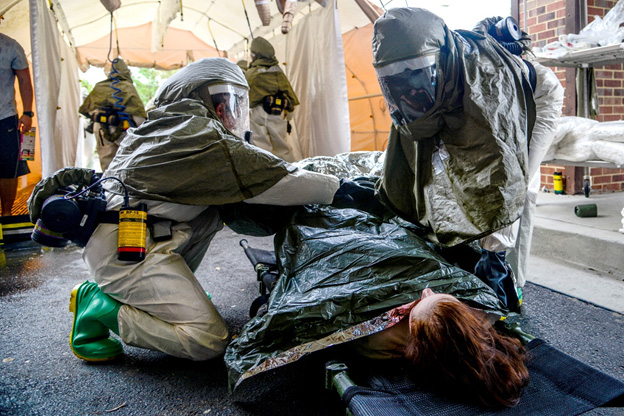Radiation incidents can happen as occupational accidents in nuclear plants, recycling facilities, or research institutions, and are often small-scale and manageable as the radiological species, and processes to mitigate further disaster, are known. This predictability is absent in radiological terrorism incidents that can utilize hazardous materials of varying complexity and are more commonly paired with conventional explosives to maximize dispersal (i.e., "dirty bombs"). A recent article in Military Medical Research by Rump and colleagues of the Bundeswehr Institute of Radiobiology in Munich, Germany, details the recommended medical management of victims of dirty bomb attacks.1
Explosive weapons are detonated in various scenarios, and victims include U.S. Service members, adversarial forces, and civilians. Medical treatment of survivors follows the guidance "treat first what kills first," a philosophy intended to prioritize the management of life-threatening physical wounds caused by secondary, tertiary, or quaternary blast mechanisms (see What is blast injury?). In scenarios in which explosives liberate radioactive material (i.e., dirty bombs causing quinary blast injury), medical management still follows standard triage rules as radiological health effects generally occur after a delay, but treatment becomes more difficult due to hazmat considerations.
Rump and colleagues emphasize that risks of secondary irradiation should not deter first responders or medical providers from attending to dirty bomb victims; instead, preparation for such circumstances should guide a prudent approach. That is, victims exposed to invisible ionizing radiation generally do not pose a threat to rescue personnel with proper equipment (i.e., protective clothing, respirators, and gloves); however, casualties contaminated with radioactive dust, debris, or shrapnel can contaminate their immediate surroundings. Therefore, treatment of urgent wounds should be weighed against possible contamination of medical personnel, vehicles, or equipment, and preliminary decontamination steps such as stripping clothing and washing are advisable because this activity can remove up to 80% of radioactive material.
Incorporation of radioactive material into the body has long term health consequences including cancer, therefore, "decorporation" drugs that bind radionuclides and facilitate their elimination, should be administered. It remains controversial whether therapeutic decorporation should begin upon suspected radionuclide incorporation ("urgent approach") or after internal dosimetry results reveal an indication for decorporation ("precautionary approach"). The Bundeswehr Institute of Radiobiology recommends the urgent approach as there is a narrow therapeutic window for radionuclide elimination and the side effects of unnecessary decorporation are minimal. While implementation of this recommendation will extend the average victim's lifespan, a thorough analysis by Rump and colleagues2 demonstrated that considerably large quantities of decorporation agents are needed in mass casualty circumstances.


1 Rump A, Becker B, Eder S, Lamkowski A, Abend M, Port M. Medical management of victims contaminated with radionuclides after a "dirty bomb" attack. Military Medical Research. 2018;5(1):27.
2 Rump A, Stricklin D, Lamkowski A, Eder S, Abend M, Port M. Analysis of the antidote requirements and outcomes of different radionuclide decorporation strategies for a scenario of a "dirty bomb" attack. American Journal of Disaster Medicine. 2017;12(4):227-241.
Your 15 minute session will timeout in approximately 10 minutes.
If you're in the middle of entering information, please close this warning and save your progress (if possible) or finish up your task.
If your session fully times out, you will lose any un-saved work.
Your current Blast Injury Research Program session has expired.
Your next click will take you away from the private area, and you will lose any work you have in-progress.
Please enter your email address, and try again.